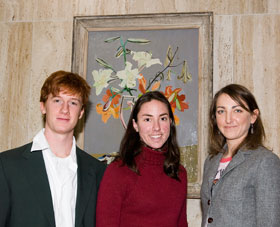  |
| HOME | THIS ISSUE | CALENDAR | GRANTS | BACK ISSUES | < BACK | NEXT > |
Medical students take the arts to terminally ill patients
by Jane Shaskan - February 6, 2006 |
||||
|
Second-year medical students at the Health Center now have an opportunity to develop their skills interacting with patients through an elective that brings the arts to the terminally ill. The program, Hospice Arts, addresses one of the most crucial and often neglected skills for a physician, the ability to make a human connection with patients, says faculty advisor Catherine Weber, an associate professor in the Department of Family Medicine. “Students are hesitant about the topic of hospice and feel uncomfortable,” says Weber, who has been involved with hospice research and education for the past 10 years, and spearheaded the program at the medical school. “To be able to connect with a patient in his or her own environment benefits both the patient and the physician.” Students earn credit for the course, which is offered as part of the medical humanities curriculum. “What a person and family deal with going through hospice is, after all, the philosophy of family medicine,” says Weber. Medical student Sarah Jane Borch, who is presently working with a 92-year-old hospice patient, says that putting herself in the patient’s space makes a big difference to how they relate to each other. “You’re more cognizant of their needs,” she says. “You become humbled in a way. They’re not in your office, you are their guest. How do you serve them in their space? “My patient lives with her daughter and has lots of family supporting her, so my visit gives family members a break as well,” Borch adds. “I’m someone different who’s visiting, someone almost neutral, so my patient can say what she likes to someone who’s listening.” Research has shown that when a patient is diagnosed with a terminal illness, caregivers, including physicians, tend to withdraw from all but the most basic interactions with the person. Hospice Arts offer a focus for interaction. “With the Hospice Arts program, patients and students interact through art,” Weber explains. “They communicate through music and dance, read poetry or literature, or work with patients on art or craft projects. We hope that students gain an appreciation for this profound phase of a patient’s life and bring the lessons of these personal experiences to later clinical encounters with all patients.” The students complete federally mandated training for all hospice volunteers. They visit patients about twice a week until the patient dies. “Being able to spend time with patients who are dying and join them in activities that they enjoy is very rewarding,” says medical student Laura Hammond.
“I’ve only had one patient, who recently passed away, but I have already grown in my ability to cope with these more difficult circumstances. I think the only way to learn how to personally deal with difficult prognoses and dying patients is simply through experience with these situations, which is exactly what this elective allows.” Katherine Mascagna, director of Connecticut Hospice in Branford, worked with Weber to establish and coordinate the program. She says medical students learn from the program “a more holistic approach to medical care. I hope this becomes a model for other medical schools as well.” Mascagna says the program also benefits patients and their families. “Exposing patients and families to the arts and encouraging creativity embraces the eternal at a point when life might otherwise seem frighteningly finite,” she says. Most of the patients have welcomed the students, she says. One patient was frustrated at not being able do the yard work he loved so much. The student created a portable rock garden for him. “The benefits the students bring to hospice patients are immeasurable – their youth, individuality, medical interest, commitment, and good intent are all extremely reassuring, engaging, and uplifting to our population,” says Mascagna. Borch, who enjoys painting and drawing, learned a new skill from her patient. “It’s really about what the patient wants,” she says. “My patient … likes to knit and wasn’t really interested in another craft, so she’s teaching me how to knit. I bought needles that were too long and we joked about that. I’m her knitting partner. She’s teaching me more than she realizes.” In addition to the Connecticut Hospice, students also work with patients through Faith Fisher at Hospice and Palliative Care of Connecticut VNA. Weber says the relationships students develop with hospice patients make the program very special. “Incredible connections are made on a human level,” she says. |
| ADVANCE HOME UCONN HOME |

